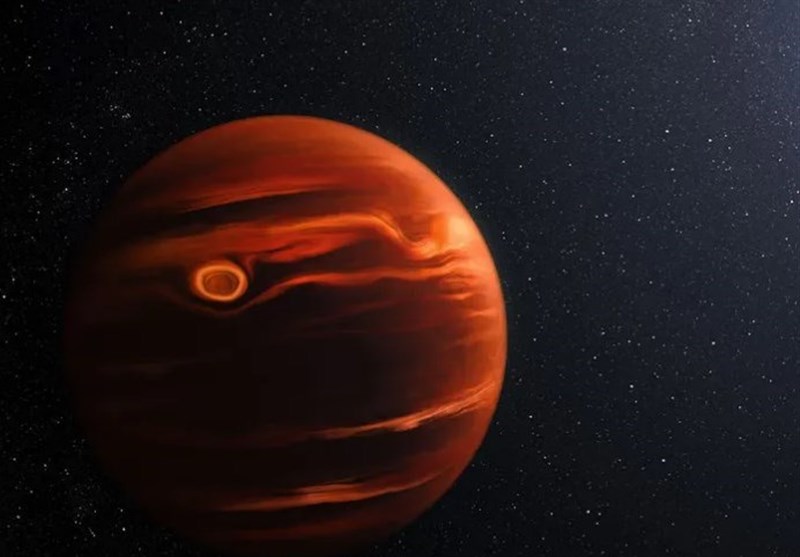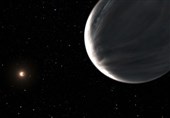Earth-Size Exoplanet May Be Covered in Volcanoes
TEHRAN (Tasnim) – Astronomers have found an Earth-size planet that isn’t like Earth at all. Instead, the exoplanet, called LP 791-18 d, is likely covered in volcanoes and may experience eruptions with the same frequency as Jupiter’s moon Io, the most volcanically active place in our solar system.
Data from NASA’s planet-hunting Transiting Exoplanet Survey Satellite, the retired Spitzer Space Telescope and ground-based telescopes was used to find the exoplanet. A study detailing the findings was published Wednesday in the journal Nature.
LP 791-18 d is located about 90 light-years from Earth in the Crater constellation, where it orbits a small red dwarf star.
Two other known planets also orbit the star, including LP 791-18 b, which is estimated to be 20% bigger than Earth, and LP 971-18 c, about 2.5 times Earth’s size and more than seven times its mass. And astronomers believe the massive planet LP 971-18 c might be contributing to the newly detected exoplanet’s possible volcanism.
As the two objects orbit their star, LP 971-18 c and the newfound exoplanet LP 791-18 d closely pass each other, allowing the gravitational pull of the larger planet LP 971-18 c to tug on planet d and reshape its orbit. With each trip around the star, planet d’s path shifts, becoming slightly more oval-shaped. The elliptical revolutions cause the interior of the planet to heat up, driving volcanic activity.
This phenomenon is similar to what occurs on Io, caught in a gravitational crossfire between Jupiter and its larger moons.
But there is no direct evidence yet to prove that volcanoes exist across LP 971-18 d.
This artist concept represents the rocky exoplanet GJ 486 b, which orbits a red dwarf star that is only 26 light-years away in the constellation Virgo. By observing GJ 486 b transit in front of its star, astronomers sought signs of an atmosphere. They detected hints of water vapor. However, they caution that while this might be a sign of a planetary atmosphere, the water could be on the star itself -- specifically, in cool starspots -- and not from the planet at all.
“We don’t know that there are any volcanoes here,” said study coauthor Ian Crossfield, associate professor of physics and astronomy at the University of Kansas in Lawrence, in a statement. “All we know is that this is a small planet that’s experiencing a straight-up periodic stretching due to its orbit around its star and near the other planets. That might cause lots of volcanoes like on Jupiter’s moon Io, which is the most volcanically active thing in our solar system. We know about that because we’ve sent things nearby and taken pictures. There’s not yet that kind of clear evidence yet with LP 791-18 d.”
Future observations of the planet could provide more data as astronomers continue the search for potentially habitable Earth-size planets.
Astronomers estimate that LP 791-18 d falls within the inner edge of the habitable zone, the distance from a star where a planet is warm enough to support liquid water on its surface.
“LP 791-18 d is tidally locked, which means the same side constantly faces its star,” said study coauthor Björn Benneke, professor of astronomy at the Trottier Institute for Research on Exoplanets at the University of Montreal, in a statement. “The day side would probably be too hot for liquid water to exist on the surface. But the amount of volcanic activity we suspect occurs all over the planet could sustain an atmosphere, which may allow water to condense on the night side.”
Although volcanic activity sounds like an impediment to water and potential life, it may actually help the planet maintain an atmosphere. Volcanoes can drive interactions between the interior and exterior of a planet.
Based on new evidence from the NASA/ESA/CSA James Webb Space Telescope, this illustration reflects the conclusion that the exoplanet LHS 475 b is rocky and almost precisely the same size as Earth. The planet whips around its star in just two days, far faster than any planet in the Solar System. Researchers will follow up this summer with additional observations with Webb, which they hope will allow them to definitively conclude if the planet has an atmosphere. LHS 475 b is relatively close, 41 light-years away, in the constellation Octans.
“A big question in astrobiology, the field that broadly studies the origins of life on Earth and beyond, is if tectonic or volcanic activity is necessary for life,” said study coauthor Jessie Christiansen, a research scientist at NASA’s Exoplanet Science Institute at the California Institute of Technology in Pasadena, in a statement. “In addition to potentially providing an atmosphere, these processes could churn up materials that would otherwise sink down and get trapped in the crust, including those we think are important for life, like carbon.”
Astronomers are intrigued by how volcanic activity can drive changes on planets. Venus, similar enough in size to Earth to be called its twin, may have once been more like our world.
“On Venus, volcanic carbon dioxide stayed in the atmosphere, pushing the planet into a runaway greenhouse state,” said study coauthor Stephen Kane, professor of planetary astrophysics at the University of California Riverside, in a statement. “Today, surface temperatures on Venus are more than 850 degrees Fahrenheit (454.4 degrees Celsius) — as hot as a wood-fired pizza oven — and odds of life there are slim. But it may not always have been that way. Volcanoes might be a big piece of the puzzle about what actually happened on Venus. Planets like LP 791-18d can shed important insights into how volcanoes shape planetary environments with time, including those of Venus and Earth.”
The larger planet LP 971-18 c is already on the list of targets that the James Webb Space Telescope will observe in the future, and now the study team believes that the newly spotted planet d is also a prime candidate. Astronomers are using the Webb telescope to search for signs of atmospheres around exoplanets and peer into them to determine the chemicals that make up these extraterrestrial atmospheres.
The discovery of LP 971-18 d points to the importance of data collected by space telescopes. The planetary system was one of the last observation targets of the Spitzer Space Telescope before the observatory was retired in January 2020.
“It is incredible to read about the continuation of discoveries and publications years beyond Spitzer’s end of mission,” said Joseph Hunt, Spitzer project manager at NASA’s Jet Propulsion Laboratory in Pasadena, California, in a statement. “That really shows the success of our first-class engineers and scientists. Together they built not only a spacecraft but also a data set that continues to be an asset for the astrophysics community.”






